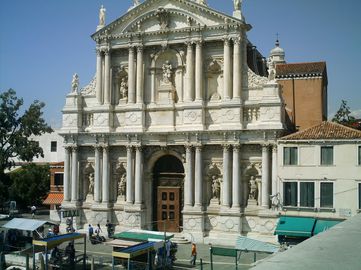

Although this church is dedicated to Mary, the mother of Christ, it is better known as the Church of the Scalzi. In Italian the word "scalzi" means barefoot. For over a hundred years, until the fall of the Venetian Republic, this church was the seat of the Discalced Carmelites, a mendicant religious order devoted to prayer and the promotion of spirituality.
The edifice was erected in the second part of the 17th century by famous Venetian architect Baldassarre Longhena on the site of a previous church and monastery. The lavish, late Baroque façade was financed by the nobleman Girolamo Cavazza and built with Carrara marble by Giuseppe Sardi. If we take a minute to study the façade, we will notice something very peculiar: one of the niches is missing a statue. It is the top right niche, in which once stood the statue of Hope. The sculpture fell and broke during the Austrian bombardment in World War I and was never replaced. The façade's bottom niches contain statues of, from the left, St. Sebastian, St. Mary Magdalene, St. Margaret and St. John the Baptist. In the second row we find St. Jerome, Faith, the Madonna and Child in the middle, then the empty niche and finally St. Bartholomew. Above the cornice we see, from the left, Eve holding an apple, Abel, Christ, Cain and Adam. The façade has been polished several times, hence its impeccable whiteness.
Inside, the single-nave church measures 45 meters in length, 25 meters in width and 24 meters in height. It contains six chapels, three on each side. Upon entering the church, to the left we see the bronze statue of Mary Immaculate, the so-called “Black Madonna.” It formerly stood in front of the railway station in order to recall the site where the Church of St. Lucy was once located before being demolished for the construction of the station. The Discalced friars bought the statue from the Italian Railway Authority in the 20th century.
The walls of the nave are decorated with traditional African marble. Between the columns we see two rows of niches with figures of the Apostles and the Evangelists. The main altar was designed by Carmelite friar Giuseppe Pozzo. It consists of eight twisted, red marble columns and four African marble pillars supporting a pyramid. On the apex of the pyramid there emerges the figure of Christ the Redeemer. A miniature temple designed by Baldassare Longhena is found in the central area of the church.
Before the Austrian bombardment in 1915 an enormous fresco by Giambattista Tiepolo, showing the translation of the house of Nazareth to Loreto, covered the entire ceiling of the church. Some of its pieces are currently preserved at the Accademia Museum. One Tiepolo fresco did survive the war, however: The glorification of St. Theresa. It is located in the chapel built in her honor. The church's present ceiling was completed on canvas by Hector Tito in 1933 and represents the proclamation of Mary Mother of God at the Council of Ephesus.
Among the 60 tombs nestled in the church, the most notable is that of Venice's last doge, Ludovico Manin, who died in 1802. His remains lie in the Chapel of the Holy Family. Manin was an original figure, though not exactly in the most positive sense. He was the only doge whose family was not a member of the old Venetian patrician class originating on the island. The Manins came from the region of Friuli and bought their way into the Venetian aristocracy in the 17th century. In fact, after Ludovico was elected Doge in 1789, one of his rivals whispered, "With a Friuliano as Doge, the Republic is dead!" The prediction came true. Eight years after his election, having cravenly maintained a policy of neutrality instead of joining various anti-French alliances, Manin handed over the Republic to French general Napoleon Bonaparte, who had entered the Venetian territory under the pretext of driving out the Austrians.